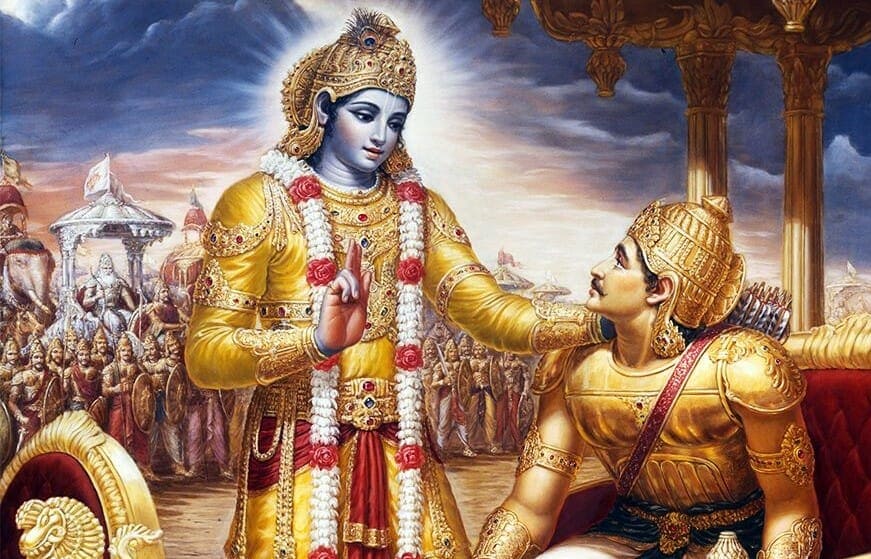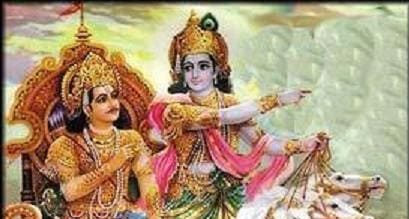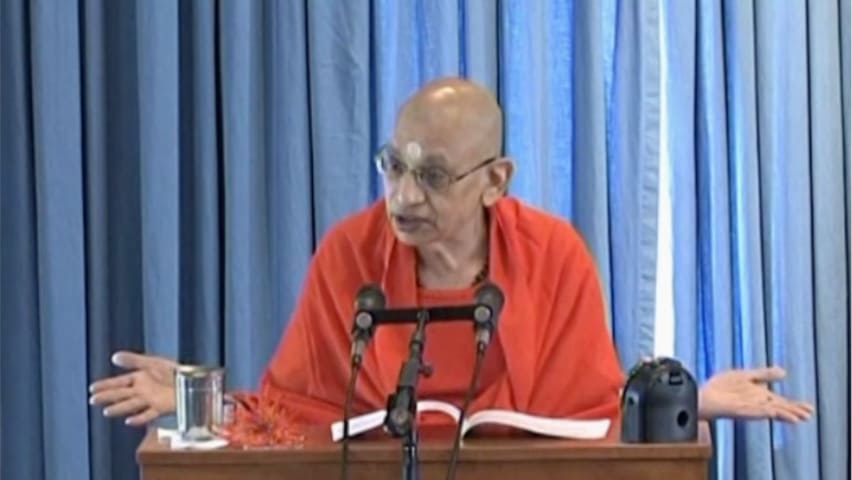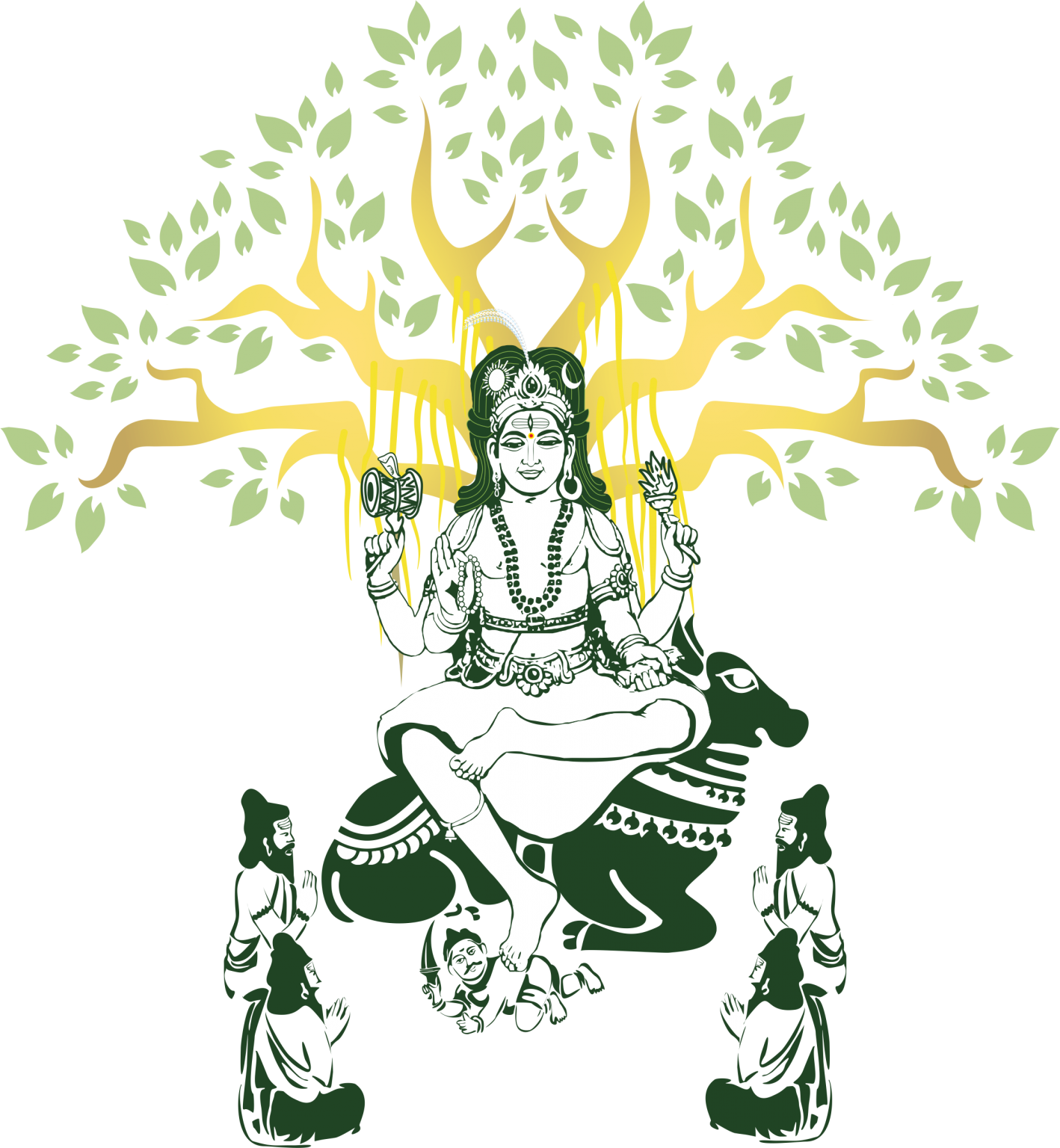Bhagavadgītā Home Study: Chapter 7, Verse 65
Published in the 13th Anniversary Souvenir of the Arsha Vidya Gurukulam, 1999.
In the previous verses, Lord Kṛṣṅa unfolded both his apara-prakṛti, consisting of the five elements, etc, and para-prakṛti, which is other than this—itaḥ anyāṃ parāṃ prakṛtiṃ viddhi. Although both must be understood, Kṛṣṅa is going to say that this [para-prakṛti] is the real prakṛti. This is my real nature, the cause for everything, and therefore it is called prakṛti. It is this prakṛti from which everything has come, which remains always the same, which is indeed the jīva, the ātmā. Therefore, understand that prakṛti to be parā, utkṛṣṭā. The other one is apara-prakṛti, the five elements, etc. Having set this up, he’s now going to reveal that there is nothing other than this para- prakṛti.
Please understand that all beings and elements have their cause in this two-fold prakṛti (Therefore,) I am the one from whom this entire world comes; so too, I am the one into whom everything resolves.
EVERYTHING HAS ITS BEING IN THIS TWO-FOLD PRAKṚTI
Etad means this two-fold prakṛti. It includes all beings beginning from Brahmāji right down to a worm. In other words, all living beings, from A to Z, and all non-living things also, from space to the earth. All of them are included. Nothing is left out. Everything known and unknown, everything that may be there in the cosmos, and whatever is there sustaining it, all the forces, all the laws, all the phenomena, then varieties of lower lokas like atala, etc., and all the beings therein, and all the higher lokas with their celestials — yakṣas, gandharvas, etc., devas — Indra, right up to Brahmāji.
With that everything is covered — all fourteen lokas, seven up and seven below. All this together is called one brahmāṅ×a. That brahmāṅ×a and everything that is there in it is sarvāṅi bhūtāni. Etad, this is the two-fold prakṛti. One is ātmā, sat-cit-ānanda-ātmā, kṣetrajña-svarūpa-ātmā, the para-prakṛti of. The other is the māyā-upādhi and because of that all the elements, etc., is the apara- prakṛti. Kṛṣṅa says, please understand this— Upadhāraya.
So, etad yonīni means those that have these (the two prakṛtis) as their causes. Yoni means cause. These two prakṛtis are the cause for everything in this jagat. Therefore, all the things in this jagat are called etad yonīni.
The apara-prakṛti is everything that there is and para-prakṛti is the real cause, satyaṃ jñānam anantaṃ brahma. That alone is the cause for everything. Please understand that prakṛti. It is jīvabhūta, in the form of jīva, ātmā, pratyagātmā. That is the real svarūpa, the real cause for everything. All the bhūtāni, space, air, mind and so on, have their being only in this, in paramātmā. All beings have their basis only in the sat-cit-ātmā. Therefore, etad yonīni sarvāṅi bhūtāni iti upadhāraya — please ascertain, come to understand that all the things in this jagat are those that have these two prakṛtis as their cause.
I AM THE CAUSE FOR THE PROJECTION AND RESOLUTION OF CREATION
The Lord says, ‘ahaṃ kṛtsnasya jagataḥ prabhavaḥ — I am the cause for the projection of this entire world.’ Which ‘I’? This ‘I’ — the one who has the two-fold prakṛti. The one that is in the form of this entire jagat – apara-prakṛti and the other one which is the real ‘I’ – satyaṃ jñānam anantaṃ brahma, the para-prakṛti And therefore, I am indeed the cause for the entire creation. Not only that. I am also the one into which this entire creation resolves — pralayastathā. Tathā – so too, kṛtsnasya jagataḥ pralayaḥ – I am the source into which everything resolves. I am the one from whom everything comes. I am the one into whom everything goes back. Therefore, there is nothing other than myself. When the creation is there, it is me because from me it has come. As I told you, this apara-prakṛti which is the pariṅāmi-upādāna-kāraṅa is also nothing but me alone.
Bhagavān has already said that all the five elements, etc., are not other than Myself; but as sat-cit-ātmā, as the kśetrajña, I have undergone no change whatsoever to become all this. So now, when he says here, ‘I am the one who is the jīva- kśetrajña, and I am the one from whom the entire world has come, and unto whom it returns,’ in effect he is saying, ‘like me, you are also the cause of this entire world.’ From the standpoint of paramātmā, you are the one who is para- prakṛti, the cause for everything. Then what is Īśvara? If you look at the jagat as an individual, then naturally you have a physical body, mind, and senses. The world is there. For all this you require a cause which is what we call māyā-upādhi. Satyaṃ jñānam anantaṃ brahma with māyā in the form of this entire world is Parameśvara.
From the standpoint of para-prakṛti, all that is there is one, without which there is no jagat at all. It alone gives sattā. It gives existence to every aspect of the creation and sphūrti, that by which you come to know each and every thing. Sattā – sat and sphūrti – cit by which this entire jagat is sustained is ātmā. That is para-prakṛti.
DEFINITION OF THE CAUSE – THE MAKER AND THE MATERIAL
In the previous verse, Kṛṣṅa said, “I am the cause of the entire creation and also its point of dissolution.” When the Lord says he is the cause, how does he mean this? As a conscious being, the nimitta-kāraṅa, he is the cause in a three-fold way — as the creator, the one into whom everything dissolves, and the one who sustains everything. Taittirīyopaniṣad also says the cause is the one from whom, yataḥ all these beings come, by whom, yena, they are sustained and into whom, yat – yasmin, they resolve.7
This is the definition of the cause. The word yataḥ represents the fifth case used in the sense of that from which something is born. This indicates the upādāna-kāraṅa, the material cause. Then he says yena, by whom they are sustained, then yasmin, unto whom they go back — yatprayantyabhisaṃviśanti. Apart from this pronoun, yat, there is no mention of any other cause. From this we understand that this kāraṅa, the cause is both nimitta-kāraṅa and upādāna-kāraṅa.
Earlier in the Taittirīyopaniṣad, it is said, ‘so’kāmayata—He desired.’ This clearly indicates the nimitta-kāraṅa. The one referred to later by the pronoun, yat, from which everything has come, upādāna-kāraṅa, is the same one who desired to become many and then created everything, nimitta-kāraṅa. From this it is clear that according to the śruti, the cause for this world is Parameśvara — both in the sense of the maker and the material.
NATURE OF THE CAUSE DEFINED
When the śāstra analyses the cause, it unfolds what we call the svarūpa, the nature of that very cause. For that it has a different definition altogether–satyaṃ jñānam anantaṃ brahma. You’ll find that none of these words, even though they are defining words, has a particular quality. In fact, these words negate all qualities. Therefore Brahman, the cause, is revealed as nirviśeṣa, free from attributes, by words which negate all the attributes we know. Thus, the cause is presented as nirvikalpa, free from any form of Duality.
The definition is that it is satya. And it is anantaṃ satyam. Therefore, it is not existent, as we usually understand — that is, its existence is not in terms of time. Similarly jñāna is not the knowledge of any given thing. It is anantaṃ jñānam, unlimited jñāna, that is limitless consciousness. This definition satyaṃ jñānam anantaṃ brahma is svarūpa-lakṣaṅa.
THE TWO TYPES OF LAKṢAṆAS
SVARŪPA-LAKṢAṆA
There are two types of lakṣaṅa, svarūpa-lakṣaṅa and taṭastha-lakṣaṅa. Svarūpa-lakṣaṅa reveals the essential nature of something. For example, if you describe water as H2O, this is svarūpa-lakṣaṅa. Water is nothing but these atoms so if you describe water as H2O, you are explaining the svarūpa of water. Here, the definition of Brahman satyaṃ jñānam anantaṃ brahma, reveals the nature of Brahman, the vastu. It negates all attributes and then points out by implication that the vastu is the existence of anything that is existent and is the content of any form of knowledge.
TAṬASTHA-LAKṢAṆA
Then if, for example, you want to indicate a certain house and do so by saying it is the house on which the crow is sitting, that is taṭastha-lakṣaṅa. The crow is not a part of the house even though it helps you recognise the house. The next time you have to identify that house you need not wait for the crow to come and sit on it. Once you recognise the house, the crow is not a part of the understanding of the house. That is called taṭastha-lakṣaṅa.
Whenever creation is discussed in the śāstra, Brahman is presented as the cause from which everything has come, by which everything is sustained and into which it resolves. Therefore, everything is Brahman. This is taṭastha-lakṣaṅa.
It is important to understand that Brahman itself has not undergone any change whatsoever to be this world. Because the world is mithyā. Anything you analyse reveals itself to be only a name and form which is reducible to another name and form which again has its being in something else.
SATYA MUST BE UNDERSTOOD TO UNDERSTAND MITHYĀ
A Buddhist will claim that, if you continue analysing like this, you will end up in non-existence. The conclusion will be that the world has its cause in the non-existent and the discovery that I am that non-existent is nirvāṅa. Nirvāṅa means extinguishing everything. This is the Buddhistic approach.
But we do not mean that. The discovery here is that, I am the only satya, the only reality. Even though the Buddhistic analysis of mithyā looks the same, it is not; because mithyā is truly mithyā only when satya is appreciated. Otherwise mithyā becomes satya, a reality. Mithyā is defined as anything that has no independent existence, no basis of its own. So by the very definition there is no such thing as mithyā without satya. Even though one may say the world is mithyā, he cannot appreciate it as such unless he appreciates satya. When the clay is appreciated as the truth of the pot, the pot is appreciated as mithyā. So only in the wake of the appreciation of satya does mithyā become clear.
TWO TYPES OF MATERIAL CAUSE—PARIṆĀMI-UPĀDĀNA-KĀRAṆA AND VIVARTA-UPĀDĀNA-KĀRAṆA
Satyaṃ jñānam anantaṃ brahma is the svarūpa of ātmā and at the same time is the cause of everything. A question now arises whether as the cause of everything it undergoes any type of change in becoming the world? Further, does it have any other material apart from itself with which it creates the world? The śāstra makes it very clear that Brahman is satya and the jagat, the world is mithyā. This being so, the world is non-separate from Brahman and so Brahman is the material cause. Here a problem arises.
Īśvara, Brahman with reference to the creation, is both nimitta-kāraṅa, the efficient cause and upādāna-kāraṅa, the material cause. We can understand, that there is an Īśvara who is all-knowing and so on, who is the efficient cause. But how can he be the material cause, for any material cause undergoes change? If the Lord himself is the material cause then he must undergo a total change to become space, air and so on.
VIVARTA-UPĀDĀNA-KĀRAṆA
Here we have to make a very careful note. When we say Brahman is the upādāna-kāraṅa of this jagat, we mean it as vivarta- upādāna-kāraṅa. This is one particular word I have not unfolded so far. Vivarta- upādāna-kāraṅa is different from simple upādāna-kāraṅa. Upadāna is the material and as a material, generally we would expect that it undergoes a change to become the effect. This is what we commonly understand as upādāna-kāraṅa. This is called pariṅāmi-upādāna-kāraṅa. It undergoes a change.
The example generally given to illustrate this is of the milk turning into yoghurt. Milk was sweet and liquid; now it is sour and semisolid. It has undergone some change. No doubt milk is the upādāna-kāraṅa for the yoghurt, but the yoghurt is definitely not in the form of milk. The milk, which is the upādāna-kāraṅa has undergone a change to become yoghurt. Similarly if the Lord, is understood to be the upādāna-kāraṅa, one may think that perhaps he also undergoes some change to become this jagat!—that is perhaps as pariṅāmi-upādāna-kāraṅa, he has indeed become the world, and as the material cause, must have undergone a change. If he has undergone a change, he is no longer in his original form. Therefore all that is here now is the world. Where is the Lord? There is no Lord at all! This is an argument raised by some people to negate the Lord being the upādāna-kāraṅa.
This is too simplistic! The Lord, no doubt, is the material cause, upādāna-kāraṅa. But he is not the pariṅāmi-upādāna-kāraṅa. He is the vivarta-upādāna-kāraṅa. That is, without undergoing any change he is the upādāna-kāraṅa. This kind of upādāna-kāraṅa is called vivarta-upādāna-kāraṅa.
The definition of vivarta is, sva-svarūpa-aparityāgena-rūpa-antara-āpattiḥ— assuming another form without giving up one’s own nature. An example is your own dream world. There you are the nimitta-kāraṅa; and you are the upādāna-kāraṅa. Without undergoing any intrinsic change, without giving up its svarūpa, ātmā has become the world in the dream. There is the subject; there is an object; there is an action. All the kārakas are involved. A kāraka is anything connected to an action.
Relationships are also included like, this is my house, this is my son etc. All these take place there without bringing about any intrinsic change in the ātmā. Ātmā, pure consciousness alone is in the form of this dream. As in the dream, so it is in this waking state.
When we say the Lord is upādāna-kāraṅa for the creation, we mean it as vivarta- upādāna-kāraṅa. It is like the rope, which, without undergoing any change, becomes the basis for the snake that is seen. Rope is vivarta-upādāna-kāraṅa for the snake.
PARIṆĀMI-UPĀDĀNA-KĀRAṆA—MĀYĀ
Since Brahman itself cannot undergo any change in order to be the cause of this creation it must have some upādhi which is as good as the creation. If the creation is mithyā, there must be an upādhi which is equally mithyā. That upādhi, we call māyā, the upādhi for Brahman to be Īśvara, the creator. We can now say, from this standpoint, that Īśvara has undergone a change to become this jagat. From the standpoint of māyā-upādhi we call Īśvara the pariṅāmi-upādāna-kāraṅa.
When we look at Īśvara, Brahman, as the cause of everything, it is as vivarta-upādāna-kāraṅa. That Īśvara you are. When I say that you are that Īśvara, I mean Īśvara as as vivarta-upādāna-kāraṅa. When we talk about the world as non-separate from Īśvara it is Īśvara that has become space, air and so on. Here we look at Īśvara from the standpoint of the māyā-upādhi which has undergone all the change. When we say Brahman, besides being the nimitta-kāraṅa, the efficient cause, he is upādāna-kāraṅa, the material cause, what we mean is that, Brahman is the vivarta-upādāna-kāraṅa. And because of vivarta-upādāna-kāraṅatva alone, it is possible to appreciate ātmā as sat-cit-ānandaṃ brahma.
One high school teacher once told me that Śaṅkara said that God became the world. In the beginning there was God and then he created the world out of himself. So God became the world. And now there is no God. It is exactly like making idli out of rice. The rice is gone; only idli is there. Later, I repeated this as Śaṅkara’s philosophy to someone and he laughed so hard that I knew that there was some mistake in what I had said. But I didn’t know what the mistake was and he didn’t correct me either.
It is obvious. The mistake is that God is taken as pariṅāmi-upādāna-kāraṅa, a material cause that undergoes a change. We require the technical term, ‘vivarta’, to understand this. Once we say Brahman is vivarta-upādāna-kāraṅa, Brahman remains as Brahman. That alone will work. Satyaṃ jñānam anantaṃ brahma always remains the same. Its svarūpa being what it is, it cannot undergo any change.
To understand the non-dual nature of Brahman, that there is nothing beyond Brahman and that the creation is not different from Brahman, this kāraṅa-kārya-vāda, discussion of cause-effect is the set-up. Through this one understands that all that is here is Brahman and I am not other than that Brahman.




